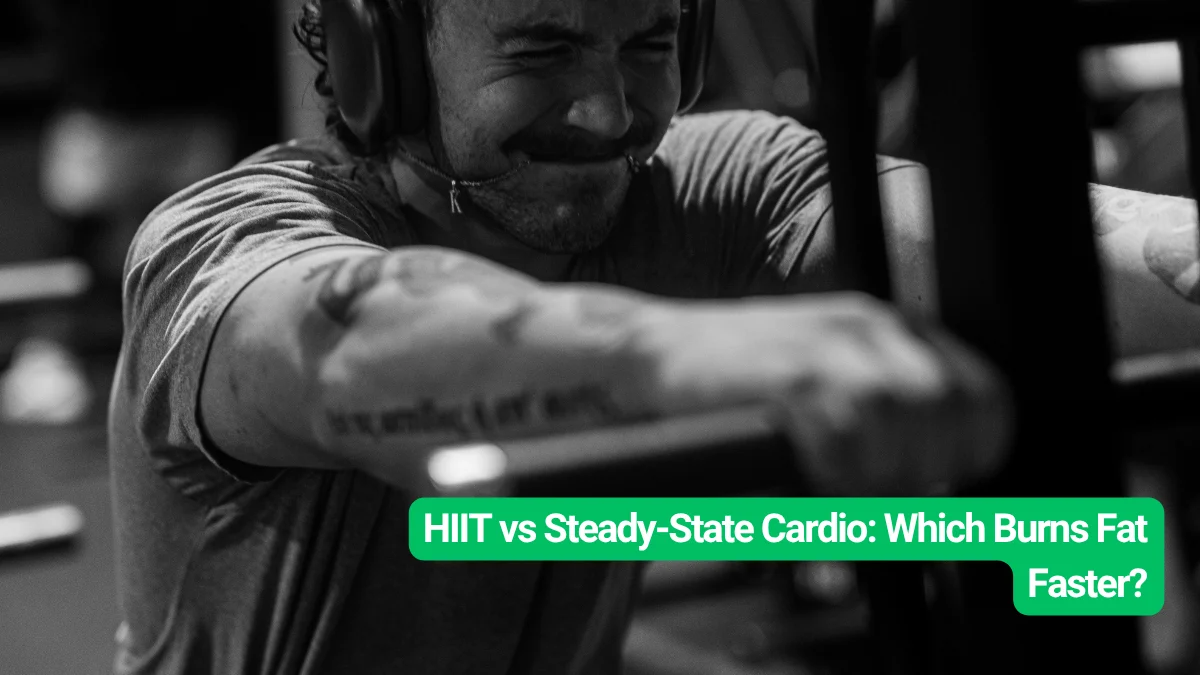Fat loss often depends on the right mix of training and consistency. Two of the most common methods people choose are high intensity interval training and steady state cardio. Both play a strong role in improving heart health and supporting fat loss, but the speed and impact of each method are different. This comparison explains how each style works, how the body reacts to them, and which one gives faster results based on your fitness level and goals.
Key Takeaways
- HIIT uses short bursts of high effort followed by recovery periods.
- Steady state cardio uses one speed for the full workout.
- HIIT can burn more calories in less time and may support a higher afterburn effect.
- Steady state is easier on the body and supports long workouts with less stress.
- Both styles help burn fat, but HIIT often shows faster changes.
- The best choice depends on fitness level, schedule, and recovery needs.
What HIIT Means
HIIT is a form of training that mixes high effort and short rest. During the intense part, the heart rate rises to 80 to 95 percent of maximum heart rate. The work period may last from 20 seconds to a few minutes, followed by recovery at a lower heart rate. The full session may last 15 to 25 minutes, depending on how fit you are.
HIIT challenges both aerobic and anaerobic systems. This mix forces the body to work hard and adjust fast. Many studies note that HIIT can improve oxygen use and stamina in a short time. The biggest reason HIIT is popular is that it lets people burn many calories in fewer minutes.
How HIIT Supports Fat Loss
The main benefit of HIIT is the high amount of energy used during and after the workout. When effort crosses into higher zones, the body uses more oxygen for many hours after exercise. This process is known as the afterburn effect, and it helps the body burn extra calories while resting.
HIIT may also support better blood sugar control and insulin sensitivity. When the body handles energy well, fat loss becomes easier. Some studies have shown HIIT can reduce abdominal fat more effectively than slower training methods.
Another benefit is time. A busy person can complete a strong session in less than half the time of most steady workouts and still see strong progress.
Risks and Limits of HIIT
HIIT is not for everyone. High intensity work puts more effort on joints, muscles, and the heart. People who are new to exercise or anyone recovering from injury should start slowly. Doing too much HIIT in a week may lead to overtraining and burnout. Many trainers suggest keeping HIIT sessions to two or three times per week to allow the body to recover.
What Steady-State Cardio Means
Steady-state cardio uses one speed and one level of intensity for the full workout. Heart rate usually stays between 50 and 70 percent of maximum heart rate. The workout may last 30 to 60 minutes, depending on preference. Walking, cycling, jogging, and swimming are common forms.
This training uses oxygen for most of the energy. It builds endurance, improves overall heart function, and strengthens slow twitch muscle fibers. These fibers help the body work for long periods without getting tired fast.
How Steady-State Helps Fat Loss
Steady training burns calories at a slower rate compared to HIIT, but it stays at a level that people can maintain longer. This makes steady work great for people who prefer long sessions. At lower intensity, the body uses more fat as fuel during the workout. Over time, steady cardio helps lower blood pressure and improves heart health.
People who are new to fat loss plans often find steady work easier because it creates less stress on the body. It also helps the body recover after harder sessions.
Limits of Steady-State
The downside is time. You need longer sessions to match the calorie burn of HIIT. Some people feel bored during long workouts. The same movement daily may also cause overuse injuries if the routine does not change. Over time, steady cardio alone may lead to plateaus if the body stops responding to the same routine.
Main Differences Between HIIT and Steady-State
- HIIT uses high effort with short breaks.
- Steady-state uses one pace for the full workout.
- HIIT burns more calories in less time.
- Steady-state is easier on joints and recovery.
- HIIT supports a stronger afterburn effect.
- Steady-state is better for beginners.
Which One Burns Fat Faster
Based on most research, HIIT burns fat faster because the short bursts of high effort increase total calorie burn. The afterburn effect also keeps metabolism higher for hours. This helps with faster results even when the workout session is shorter.
However, steady cardio still works for fat loss. It helps people train without high stress and supports consistent calorie burn. Anyone who prefers long slow workouts or has joint limitations may see steady progress with steady state.
How to Choose Between the Two
Your choice depends on your schedule and fitness level.
Choose HIIT if you want quick workouts, faster fat loss, and a higher metabolic push.
Choose steady-state if you prefer longer sessions, lower stress, and a routine that feels easier to maintain.
A combination works best for most people. Many training plans include two days of HIIT and one or two days of steady-state. This mix supports fat loss, improves endurance, and protects recovery.
Final Thoughts
Both HIIT and steady-state cardio help burn fat and improve heart health. HIIT offers faster results due to its intensity and strong afterburn effect. Steady-state supports long sessions with less strain. The best long term plan is to choose the style that fits your energy, schedule, and comfort. Consistency builds results, not one single workout style.




